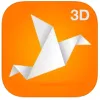Take a look inside 5 images
How to Make Origami
Pros: A nice variety of projects and the ability to see folding dynamically give the app a boost.
Cons: "Unfold" lines and background info about origami are missing.
Bottom Line: How to Make Origami provides students with a dynamic way to learn paper folding.
Students could complete projects individually in free time (be sure to keep a variety of paper on hand), or classes could work on projects together simultaneously with an overhead projector. Since most of the action is outside of the app itself and finished products are not saved, user profiles are not necessary. It's a good idea to try out each project before presenting it to students -- you may be surprised at the level of difficulty of some of the pieces. The app doesn't give much info about the history or general principles of origami, so you may want to research this info and present it to students; older students could do their own research.
How to Make Origami is well-designed, easy to follow, and colorful, but some projects will be challenging for beginners. The main menu shows 24 projects by name with number of steps. Kids can tap the forward, back, or replay buttons at any time. Like real origami paper, the back side of the paper is white to clarify sides. Most projects have 14 to 20 steps. The Get More Origami button on the main page redirects to SetHow.com with more how-to projects in addition to origami.
Projects are not ordered by level of difficulty, and the number of steps does not guarantee an easy project: Even the Penguin with 11 steps has complicated instructions to fold, then unfold, then fold a different direction on the fold line. The one drawback is the lack of crease or "unfold" lines, which will pose difficulties. Though challenging, the Lily with 33 steps is possible for grade 8 students but not likely for grades 3 and 4.
While origami is not a traditional element of math curricula, it is a highly accessible way for kids to explore real-world applications of math concepts that are artful as well as logical. Each step is described with words (some more important than others) and a dynamic demonstration of the folds required -- a big improvement over the classic diagrams that use arrows to show folds.
Kids will get practice partitioning shapes into parts with equal areas, and recognizing lines of symmetry for two-dimensional figures. Older kids will get opportunities to verify experimentally the properties of rotations, reflections, and translations, and to understand that a two-dimensional figure is congruent to another if the second can be obtained from the first by a sequence of rotations, reflections, and translations.












